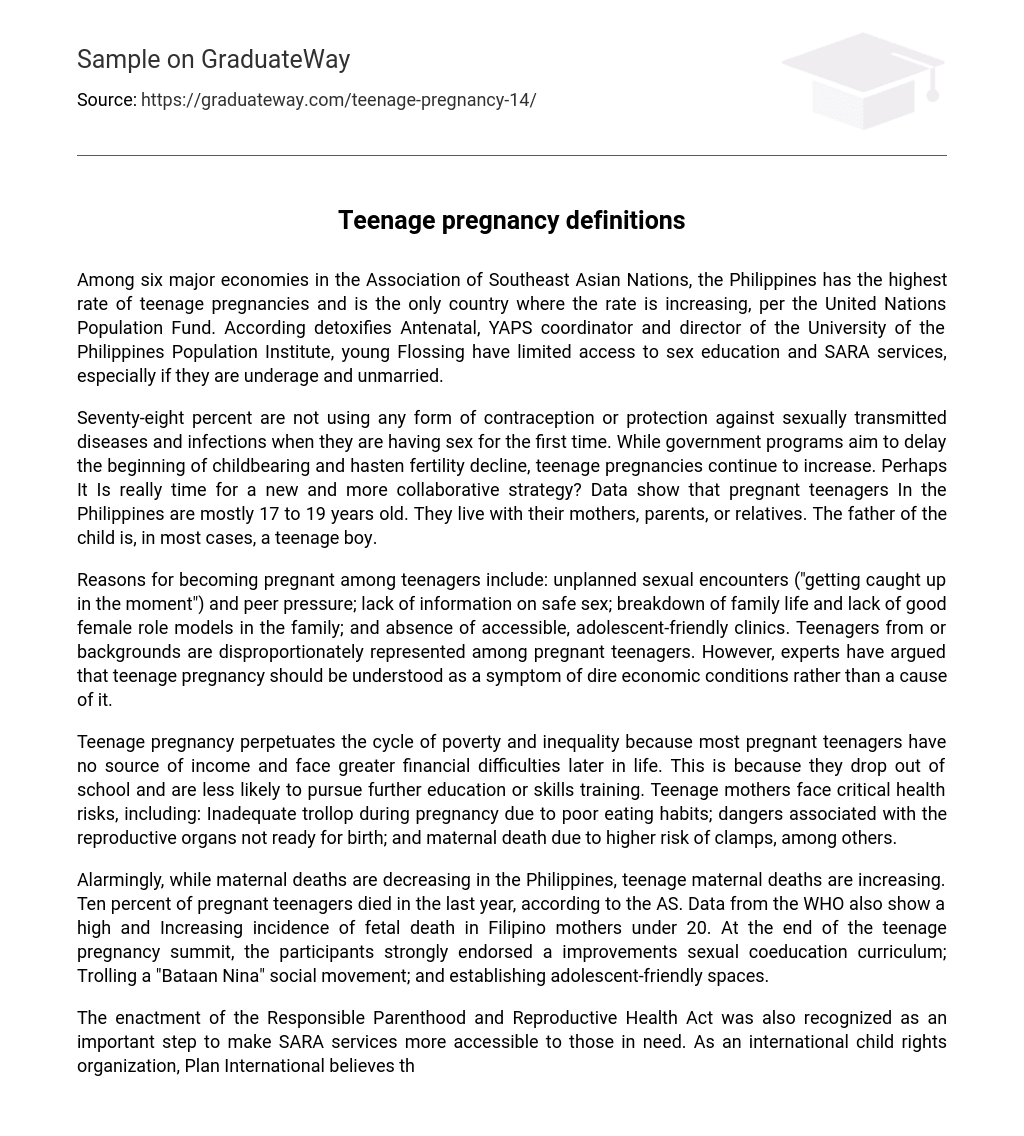According to the United Nations Population Fund, the Philippines has the highest rate of teenage pregnancies among the six major economies in the Association of Southeast Asian Nations. It is also the only country where this rate is increasing. The director of the University of the Philippines Population Institute and Antenatal, YAPS coordinator, stresses that young individuals in the Philippines face challenges such as limited access to sex education and SARA services, particularly if they are underage and unmarried.
The majority of individuals (78%) engage in their first sexual experience without using any form of contraception or protection against sexually transmitted diseases and infections. Even though the government has implemented programs to discourage early childbearing and decrease fertility rates, teenage pregnancies are on the rise. Perhaps it is time to consider a new approach that involves collaboration. Data indicates that a significant number of pregnant teenagers in the Philippines fall between the ages of 17 and 19, and they typically reside with their mothers, parents, or relatives. In numerous instances, the father of the baby is also an adolescent.
Teenagers become pregnant for various reasons, including participating in unplanned sexual encounters and succumbing to peer pressure. Insufficient knowledge about safe sex, familial problems, and a lack of positive female role models at home also contribute to this issue. Moreover, the scarcity of clinics dedicated to teenagers exacerbates the problem. Teenagers from disadvantaged backgrounds are especially susceptible to teenage pregnancy. Nevertheless, experts contend that teenage pregnancy should be viewed as a result of severe economic circumstances rather than its root cause.
Teenage pregnancy perpetuates poverty and inequality as pregnant teenagers often lack income sources and encounter greater financial challenges in the future. This is primarily because they drop out of school and are less likely to pursue further education or skills training. In addition, teenage mothers face significant health risks including inadequate nutrition during pregnancy caused by poor eating habits, complications resulting from unprepared reproductive organs for childbirth, and a higher risk of maternal death due to clamps, among other issues.
In an alarming trend, the Philippines is witnessing a decrease in overall maternal deaths but a disturbing increase in teenage maternal deaths. According to the AS, 10% of pregnant teenagers lost their lives in the past year. Data from the WHO also reveals a high and growing number of fetal deaths among Filipino mothers under the age of 20. The participants of the teenage pregnancy summit strongly advocated for several measures to address this issue, including enhancing the sexual coeducation curriculum, promoting the “Bataan Nina” social movement, and establishing spaces that cater to the needs of adolescents.
The enactment of the Responsible Parenthood and Reproductive Health Act is seen as a significant move to increase accessibility to SARA services for those who require them. Plan International, an international child rights organization, stresses the importance of guaranteeing the rights and needs of adolescent girls and boys, including their access to SARA services. In our work in the Philippines, prioritizing SARA aligns with our global “Because I’m a Girl” campaign and national Bataan Lulus program.
In response to the increasing cases of teenage pregnancy in Southern Elite and Eastern Samara, we are implementing SARA interventions. To provide peer education and counseling on SARA and rights, we are establishing Youth-Friendly Spaces. Additionally, to eliminate gender-based violence in communities, we are setting up Women-Friendly Spaces. These measures aim to prevent teenage pregnancy by disseminating accurate information regarding the risks and impacts of becoming pregnant as a teenager, both for the teen mom and the infant.
Plan International is conducting an exploratory study on the rise of teenage pregnancy in areas affected by Mainland’s disaster. Despite facing discrimination, gender-based violence, and harmful gender stereotypes, it is essential for Filipino adolescents to have access to life skills and resources that empower them to make informed choices about their well-being and community progress. When teenagers choose to be sexually active, they have the right to receive information and utilize comprehensive sexual and reproductive health services.





